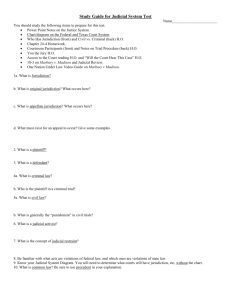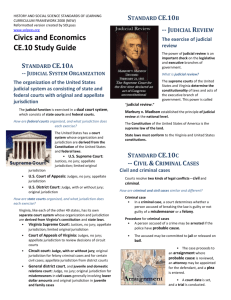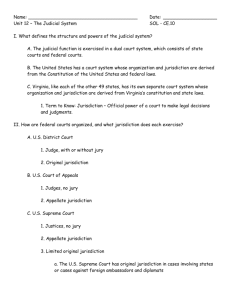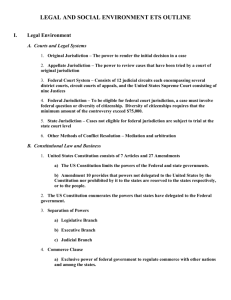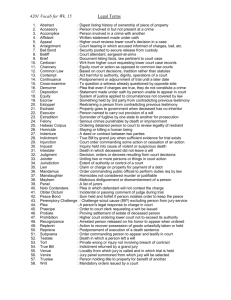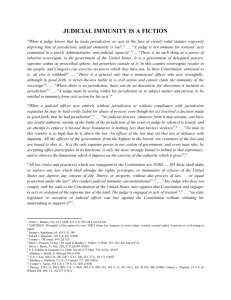CJ 211 Study Guide
advertisement
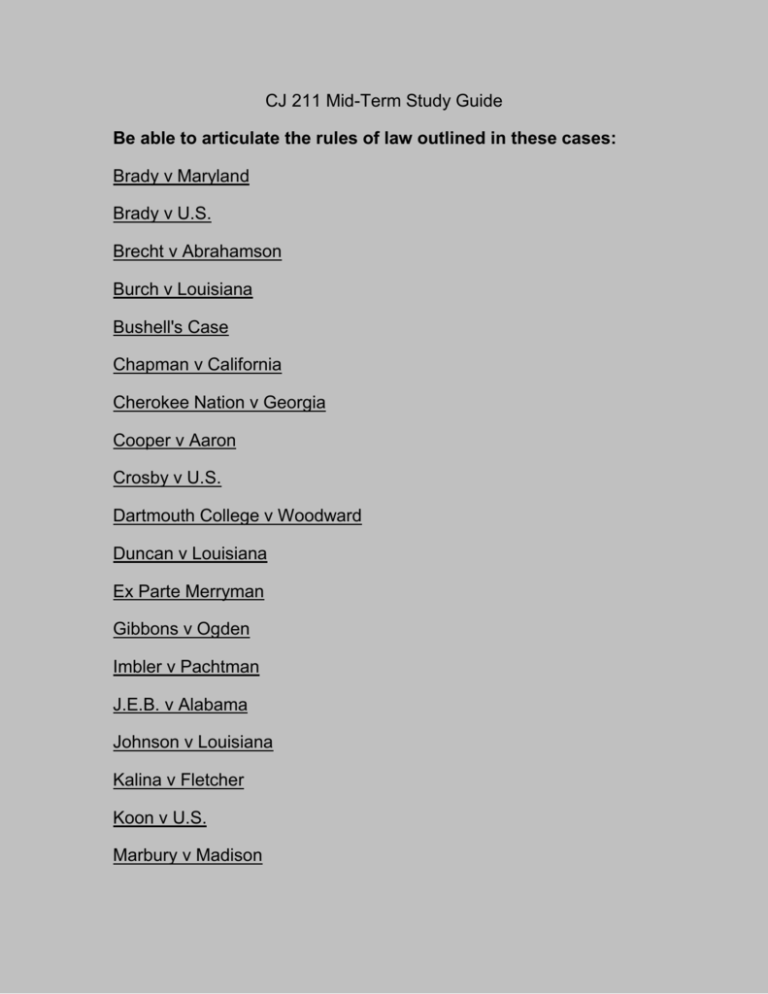
CJ 211 Mid-Term Study Guide Be able to articulate the rules of law outlined in these cases: Brady v Maryland Brady v U.S. Brecht v Abrahamson Burch v Louisiana Bushell's Case Chapman v California Cherokee Nation v Georgia Cooper v Aaron Crosby v U.S. Dartmouth College v Woodward Duncan v Louisiana Ex Parte Merryman Gibbons v Ogden Imbler v Pachtman J.E.B. v Alabama Johnson v Louisiana Kalina v Fletcher Koon v U.S. Marbury v Madison Martin v Hunter's Lessee McCulloch v Maryland Michigan v Harvey North Carolina v Pearce Patton v U.S. Powers v Ohio Singer v U.S. Stack v Boyle State ex rel Unnamed Petitioners v Connors Stone v Powell Taylor v Taintor Teague v Lane U.S. v Bagley U.S. v Havens U.S. v Nixon U.S. v Salerno Weatherford v Bursey Williams v Florida Worcester v Georgia Youngstown Sheet and Tube Co. v Sawyer Zenger’s Case Be able to identify these terms/concepts/ideas in detail: allocution amicus curiae bail bond (different types and different time frames) bill of particulars bench trial (why judges don’t like them) change of venue (trial venue/jury venue) challenge the jurisdiction (list all four kinds) clemency (differentiate between clemency and commutation; why granted) commutation concurrent jurisdiction consolidation hearing coram nobis corner’s inquest (who present, what happens, standard of proof, possible outcome) diversive jurisdiction exclusive jurisdiction ex post facto appeal expert testimony expungement (differentiate between expungement and pardons) fundamentally fair grand jury (as differentiated from a petite jury) harmless error hearsay evidence (4 specific tests) impeachment interlocutory appeal (who generally files, why, process dynamics, why so rare) initial appearance (where held, who present, what happens, etc) joinder judicial notice jury nullification motion in limine (define, why granted) motion to quash nolo contendere objections (list the 10 kinds as discussed in class) omnibus hearing order of preclusion (define, why granted) overlapping jurisdiction pardon (review the dynamics of receiving a pardon, list the 3 legal impacts of receiving a pardon, and the 7 reasons that pardons are granted) plea in abatement (who, where, when, why) plea of jeopardy plea of standing mute (why is it used; what are the 4 challenges) plea of statute of limitations plea to the jurisdiction (what are the 3 challenges) preliminary hearing (where held, who present, what happens, standard of proof, possible outcomes) privileged communication (5 types; why court allows) recuse severance hearing slow plea of guilty/summary judgment (where, who involved, desired outcome/purpose) spontaneous declaration (3 specific tests) stipulation writ of demurrer Be able to answer these essay questions: l. Discuss hearsay evidence issues - what four specific tests must be met for any hearsay evidence to be admitted as evidence in court; what three tests must be met for a spontaneous declaration to be admitted as evidence in court; what test must a dying declaration meet to be admitted as evidence in court. 2. Determine the flow of events in the justice process - really have this one nailed down. 3. Differentiate between a bind over, a complaint, a true bill/indictment, and a writ of information. 4. Preliminary hearing issues and procedures - what transpires at a preliminary hearing, who can have them, who does what, how do they proceed, level of proof required, possible outcomes? 5. Review Jefferson's opinion of the Marbury case and his overall attitude toward judicial review. 6. Review the factors that we discussed in class that affect a prosecutor’s decision to re-file (5 factors) or not re-file (5 factors) a case after it has been remanded for re-trial subsequent to a successful appeal. 7. Review the standards whereby a successful civil suit might be brought against the police for false arrest/illegal arrest and/or against the prosecutor for malicious prosecution. Review two court cases that speak specifically to this issue. 8. List and discuss the reasons why prosecutors may decide not to prosecute a case (we will list 20 in class). 9. List and discuss the things that can be done to get a criminal case prosecuted if the county attorney won’t file. 10. In what ways do grand juries function as a crime control mechanism? 11. Explain the harmless error doctrine as outlined in Chapman v. California. In what way is it reflective of the crime control model? In what way is it reflective of the due process model? 12. What are the factors that would be considered in determining where a case would be prosecuted in the event that there is overlapping jurisdiction? 13. What is an interlocutory appeal and why are they used so rarely? 14. When can and when can't a sentence be increased after a reconviction subsequent to a successful appeal? What court case speaks to this issue? 15. Explain the concept of discovery (formal and informal dimensions), and articulate the rules of law handed down in Weatherford v. Bursey, Brady v. Maryland and U.S. v. Bagley. 16. Explain the concept of the zone of indifference as it applied to the courts. 17. List five types of privileged communication relationships - why do the courts allow information shared in such relationships to remain secret and under what circumstances may each privileged communication relationship be breached. 18. Describe the voir dire process. 19. List and discuss four reasons that a judge might grant an order of preclusion. 20. List and discuss five reasons that a judge might ask an expert witness to step down and order that their testimony be excluded from the court record. 21. What are the five options that could result subsequent to a preliminary hearing in which probable cause was not found? 22. Discuss the historical development of the American court system starting with the medieval English model. 23. Explain the concept of the "King's Peace," and discuss how the development of that notion impacted upon the development of the contemporary judicial system. 24. Distinguish between a dismissal with and without prejudice. 25. What can trial judges do during the general adjudication process to correct what they see as miscarriages of justice? Review options that they have in each of the four conceptual time frames as discussed in class. 26. Discuss the power relationship between the Supreme Court and the President. Should the Supreme Court be able to review Presidential actions? What is the Presidential argument? List at least two court cases/scenarios to support your position. 27. Differentiate between pardons and expungements. 28. What possible sanctions might an individual prosecutor face for failing to comply with the discovery requirements (ie., they withheld/concealed exculpatory evidence; evidence that is favorable, material and of substantial weight from the defense standpoint)? ******************************************************************************* ************************************************************ CJ 211 Final Exam Study Guide The final exam will be comprehensive. Consequently you should take the time to review the study guide supplied for the mid-term. In addition, be familiar with the material that follows. Be able to articulate the rules of law outlined in these cases: Chandler v Florida Chisholm v Georgia Estes v Texas Farretta v California McMann v Richardson Pulliam v Allen Be able to identify these terms/concepts/ideas: concurring opinion dissenting opinion dicta en banc in camera in forma pauperis injunction/mandamus khadi justice legal efficacy legislative default log rolling Lord Chancellor majority opinion olive leaf ordinary error per curiam decision pro bono pro se seriatim sociological jurisprudence special masters undue hardship writ of certiorari Be able to answer these essay questions: 1. Discuss the evolution of the presence of cameras in the court room. Discuss the two leading cases. What is the current law? 2. Discuss the pros and cons of allowing television cameras into the courtroom. 3. In what ways is the legislature considered to be a part of the judicial system? 4. In what ways are the police part of the judicial system? 5. In what ways are correctional officials part of the judicial system? 6. What does the Williams study say regarding attorney negotiation skills? 7. Discuss Blumberg's arguments regarding the practice of law. 8. Explain the different ways judges are selected. 9. Discuss the different ways to remove a judge from office. 10. Discuss the pros and cons of the rent-a-judge concept. 11. List and discuss several reforms that might be used to deal with jury problems. 12. What are the responsibilities of the minor trial courts. 13. What are the responsibilities of the major trial courts. 15. List and discuss a number of factors that influence prosecutors in their charging and bargaining decisions. 16. List and discuss a number of reforms that address the problem of court delay. 17. List and discuss a number of factors that seem to influence Supreme Court decision making. 18. List and discuss a number of reforms that deal specifically with issues of sentencing problems. 19. List and discuss a number of powers and offices held by the Chief Justice of the United States. 20. List a number of reasons why we are experiencing an increase in the number of cases appealed of late. 21. Discuss the history and development, and the current state of affairs with respect to the 3 “world courts.” 22. Review the principles outlined by Murton in his model of successful reform.

